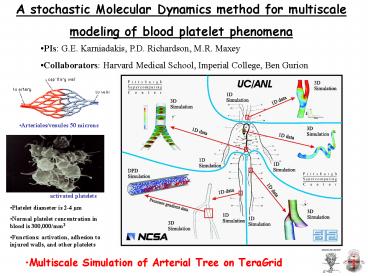Visualization of Platelets in Small Blood Vessels - PowerPoint PPT Presentation
1 / 16
Title:
Visualization of Platelets in Small Blood Vessels
Description:
A stochastic Molecular Dynamics method for multiscale. modeling of blood platelet ... This approach leads to an effective potential similar to one, used in DPD. ... – PowerPoint PPT presentation
Number of Views:42
Avg rating:3.0/5.0
Title: Visualization of Platelets in Small Blood Vessels
1
A stochastic Molecular Dynamics method for
multiscale modeling of blood platelet phenomena
- PIs G.E. Karniadakis, P.D. Richardson, M.R.
Maxey - Collaborators Harvard Medical School, Imperial
College, Ben Gurion
- Arterioles/venules 50 microns
activated platelets
- Platelet diameter is 2-4 µm
- Normal platelet concentration in blood is
300,000/mm3 - Functions activation, adhesion to injured walls,
and other platelets
- Multiscale Simulation of Arterial Tree on TeraGrid
2
Platelet Aggregation
RBCs are treated as a continuum
Pivkin, Richardson Karniadakis, PNAS, 103 (46),
2006
3
Small Aggregates, no RBCs
The increase in volume of platelet aggregate is
plotted semi-logarithmically against time.
Effect of mean blood flow velocity on the growth
rate constant (s-1) of platelet aggregate.
Simulation results qualitatively agree with
experimental data from Begent and Born
Begent and Born, Nature, Vol. 227, No. 5261, pp.
926-930, 1970
4
Platelet Aggregation and RBCs
Model RBCs as rigid spheres of large diameter
5
Small aggregates, RBCs
The increase in volume of platelet aggregate is
plotted semi-logarithmically against time.
Effect of mean blood flow velocity on the growth
rate constant (s-1) of platelet aggregate.
Black curves platelets only Red curves
platelets in the presence of large spheres
6
Increase of aggregate growthfor large aggregates
Black curves platelets only Red curves
platelets in the presence of large spheres
7
Dissipative Particle Dynamics (DPD)
- Dissipative Particle Dynamics (DPD) was
introduced by - Hoogerbrugge and Koelman in 1992
- Particles interact through a simple pair-wise
potential - The DPD scheme consists of the calculation of the
position and velocities of interacting particles
over time. The time evolution of positions and
velocities are given by
P.J. Hoogerbrugge and J.M.V.A. Koelman,
Europhys.Lett.,19155-160, 1992
8
Conservative Force
From Forrest and Sutter, 1995
Soft potentials were obtained by averaging the
molecular field over the rapidly fluctuating
motions of atoms during short time intervals.
This approach leads to an effective potential
similar to one, used in DPD.
9
Dissipative and Random Forces
- Dissipative (friction) force is reducing the
relative velocity of the pair of particles - Random force compensate for eliminated degrees
of freedom - Dissipative and random forces form DPD
thermostat - The magnitude of dissipative and random forces
are defined by - fluctuation dissipation theorem
10
Solid Objects in DPD
Solid objects are modeled by collections of DPD
particles.
11
Deformable RBCs
Membrane model J. Li et al., Biophys.J, 88
(2005)
bending and in-plane energies, constraints on
surface area and volume
- Coarse RBC model
- 500 DPD particles connected by links
- Average length of the link is about 500 nm
- RBCs are immersed into the DPD fluid
- The RBC particles interact with fluid particles
through DPD potentials - Temperature is controlled using DPD thermostat
12
Biconcave and Cup Shapes
Deflating sphere to 65 of volume
13
Shear
14
Microchannel
Experiment by Stefano Guido, Università di
Napoli Federico II
15
RBCs
16
Open Issues
- Identify effective parameters for coarse RBC
membrane - Investigate dimensional consistency in DPD
- Validation with experiments, optical
tweezers(MIT) or microchannel flow(MIT/Italy) - Stress-free constraint































